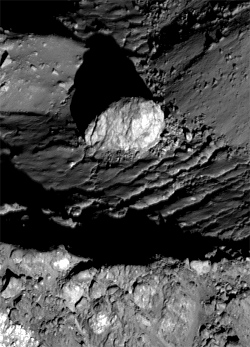[/caption]
A team of researchers at India’s Physical Research Laboratory (PRL) claims it has found evidence of relatively recent volcanic activity on the Moon, using data from NASA’s Lunar Reconnaissance Orbiter and the Chadrayaan-1 spacecraft. According to the findings the central peak of Tycho crater contains features that are volcanic in origin, indicating that the Moon was geologically active during the crater’s formation 110 million years ago.
In an article by the Deccan Herald, a Bangalore-based publication, the PRL researchers claim that vents, lava channels and solidified flows of inner crustal material found within Tycho were made as recently as 100 million years ago — after the creation of the crater.
This could indicate that there was pre-existing volcanic activity within the Moon at the site of the Tycho impact, lending credence to the idea that the Moon was recently geologically active.
In addition, large boulders ranging in size from 33 meters to hundreds of yards across have been spotted on Tycho’s central peaks by LRO, including one 400-foot (120-meter) -wide specimen nestled atop the highest summit. How did such large boulders get there and what are they made of?

The researchers hint that they may also be volcanic in origin.
“A surprise findings revealed the presence of large boulders–about 100 meter in size –on top of the peak. Nobody knew how did they reach the top,” said Prakash Chauhan, a PRL scientist.
Without further studies it’s difficult to determine the exact origin and ages of these lunar formations. The team awaits future research by Chandrayaan-II, which will examine the Moon from orbit as well as land a rover onto the lunar surface. Chandrayaan-II is expected to launch in early 2014.
The PRL team’s findings were published in the April 10 issue of Current Science.
Read the article in the Deccan Herald here.


Recently??? I understand that word is being used in a geological context, but it’s still hard for me to equate “recent” and “100+ million years”.
Good point. But I think, like in similar cases on Mars, that we are comparing with the age of the body. ~ 100 Ma vs ~ 4.5 Ga = ~ 2 % of the lifetime. That is relatively recent.
Implying that if the body have had an active core for 98 % of its lifetime, what are the odds it would have stopped just as we were able to observe it?
It’s simple! *Strikes a Giorgio A. Tsoukalos from History Channel pose* Ancient Aliens.
Fascinating. Not so much the possible “recent” volcanism, but the huge boulder sitting atop a central Crater Peak. I take it, after the initial impact, the area was still molten, so a cleanly-placed boulder of such size could not have wound up where it now stands (assuming it has the weight to match its bulk).
What a light show, thrilling – and fearful – that crater formation event might have presented, as seen from the night-side of Earth!
What would Science be, if new discoveries did not unfold unsolved mysteries to seize the mind, arouse the curiosity, and fire the imagination!
Given Tycho crater is 43km in radius and 4.8km in depth, I would estimate the impacting asteroid to have been about 3 to 5km in radius. This would have been a mass extinction event if it had hit the Earth.
The impact appears to have punched a crack into the lunar mantle. This might have been the source of this volcanism.
LC
Chesapeake Bay crater is 85km in diameter and it, and its possible companion, the 100km diameter Popigai crater (both ~35Mya) didn’t cause anything beyond localized destruction.
So, no.